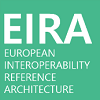Introduction
With the growing amount of information exchanges between public services (across borders and sectors), the need for interoperability in Europe is higher than ever. Interoperability can be defined in many ways. The simplest way could be: “The ability to exchange information”. To address interoperability issues at national, regional, or local levels, many public administrations already have or are in the process of developing interoperability frameworks. The scope of these frameworks is restricted to the jurisdictions within which they have been developed. However, European public administrations must be ready to work together to deliver cross-border public services to meet the needs of businesses and citizens. The ISA² Action 2.1 (EIA) introduced the European Interoperability Reference Architecture (EIRA) to guide public administrations in their work to provide interoperable European public services to businesses and citizens. This document introduces the European Interoperability Reference Architecture (EIRA©), which is maintained in the context of the Digital Europe Programme (DEP). The EIRA© is a reference architecture focused on the design of End-to-End interoperable digital public services. It is composed of the most salient Architecture Building Blocks (ABBs) needed to promote cross-border and cross-sector interactions between public administrations. The latest release of the EIRA© is available on Joinup.
Purpose of this page
This document introduces the reader to the benefits of EIRA© and to the basic concepts needed to understand it. It is not the purpose of this document to provide guidelines on how to use EIRA©.
Structure of this page
This page consists of the following sections:
- Chapter 1 provides an overview of the EIRA©. It includes background information and elaborates on its objectives, target users and use cases, expected benefits, user community and continuous improvement;
- Chapter 2 provides further insight into several key concepts related to the EIRA©. It also provides insight on how to use EIRA© in combination with the ArchiMate® notation and Archi®;
- Chapter 3 provides an overview of the EIRA© views, viewpoints and its Architecture Building Blocks;
- Chapter 4 contains a glossary of EIRA referenceable terms/ABBs;
- Chapter 5 contains references;

